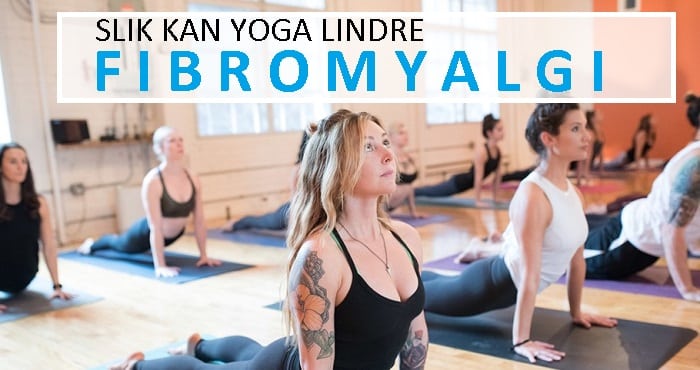How Yoga Can Relieve Fibromyalgia
How Yoga Can Relieve Fibromyalgia
Here you can read more about how yoga can be involved in relieving chronic pain diagnoses - such as fibromyalgia.
Fibromyalgia is a chronic pain diagnosis that causes significant pain in the muscles and skeleton - as well as poorer sleep and cognitive function (such as memory). Unfortunately, there is no cure, but now several studies have shown that yoga can be part of the solution for this vulnerable patient group - and then often in combination with physical treatment, modern chiropractic, massage and medical acupuncture.
Yoga is a form of exercise that can adapt to the individual person and their medical history. Yoga combines relaxation, meditation, stretching exercises and deep breathing techniques - with the aim of giving the practitioner better self-awareness, improved body control and a new tool for focusing on things other than pain. Tai chi and qi gong are two other forms of relaxation therapy that those with chronic pain can benefit from.
Too many people are plagued with chronic pain that destroys everyday life - that's why we encourage you to Share this article in social media, Feel free to like our Facebook page and say: "Yes to more research on fibromyalgia". In this way, one can make the symptoms associated with this diagnosis more visible and ensure that more people are taken seriously - and thus get the help they need. We also hope that such increased attention can lead to greater funding for research on new assessment and treatment methods.
We know that yoga is not suitable for absolutely everyone, but fortunately there are many different versions that are also adapted for those with even the strongest pain (for example, relaxation yoga). Here are some of the different types of yoga available:
ashtanga-yoga
relaxation Yoga
Bikram yoga
hatha yoga
Classical yoga
kundalini-yoga
Medical yoga
Studies have not been able to define which type of yoga is best suited for those with fibromyalgia, but based on the diagnosis' presentation and its pain pattern, it is known that the calmer versions of yoga are best suited for the majority - as it teaches students to handle the pain in a better way and to lower the tension level.
Also read: - 7 Exercises for Rheumatists
Yoga and fibromyalgia: What does the research say?

A number of research studies have been conducted that looked at the effect yoga has on fibromyalgia. Among other things:
A study from 2010 (1), with 53 women affected by fibromyalgia, showed that an 8-week course in yoga improved in the form of less pain, fatigue and improved mood. The course program consisted of meditation, breathing techniques, gentle yoga postures and instruction to learn to deal with the symptoms associated with this pain disorder.
Another meta-study (collection of several studies) from 2013 concluded that yoga had an effect in the form of improving sleep quality, reducing fatigue and fatigue, and that it resulted in less depression - while those involved in the study reported an improved quality of life. But the study also said that there is not enough good research yet to firmly establish that yoga was effective against fibromyalgia symptoms. The existing research does look promising.
Our conclusion after reading several studies is that yoga can definitely play a role for many in a holistic approach to relieving fibromyalgia and chronic pain diagnoses. But we also believe that yoga must be adapted to the individual - not everyone benefits from yoga with too much stretching and bending, as this can provoke flare-ups in their condition. The key is to know yourself.
Also read: This You Should Know About Fibromyalgia
More information? Join this group!
Join the Facebook group «Rheumatism and Chronic Pain - Norway: Research and news»(Click here) for the latest updates on research and media writing about chronic disorders. Here, members can also get help and support - at all times of the day - through the exchange of their own experiences and advice.
Other health benefits of yoga

The studies we mentioned earlier looked in particular at the link between fibromyalgia and yoga - but we also want to mention that yoga has other positive, documented effects. Several studies have shown that yoga can reduce stress, as well as contribute to better physical and mental health. It is believed that practicing yoga reduces the presence of a hormone called cortisol - also known as the "stress hormone". And not surprisingly, this results in a less stressed body and brain.
What other measures can relieve fibromyalgia?

There are a number of other well-documented measures that can help reduce pain related to fibromyalgia.
Some of these measures include:
Acupuncture: Acupuncture involves treatment with acupuncture needles. The purpose of the treatment is to dissolve in tight muscle knots, contribute to increased blood circulation and thus help to reduce muscle and tendon pain. Such treatment should be performed by a publicly licensed clinician.
Massage: Muscular techniques and massage can help reduce stress and muscle tension. This form of treatment can also work well for those affected by anxiety.
Modern Chiropractic: Fibromyalgia is a condition consisting of both muscle and joint pain. Therefore, having a modern chiropractor (one who works with both muscles and joints) in the back can be worth its weight in gold for someone who is affected by fibro. Sometimes you need a little extra movement to loosen up deep muscles - and then it is beneficial with chiropractic joint mobilization.
Sleep hygiene: For those with fibromyalgia, sleep is extra important. Good sleep hygiene means going to bed at the same time of day - every day - and avoiding afternoon naps that can affect nighttime sleep.
VIDEO: Exercises for Rheumatists and Those Affected by Fibromyalgia
Feel free to subscribe on our channel - and follow our page on FB for daily health tips and exercise programs.
We really hope that yoga can be something for you - and that it can help you on the way to less pain in everyday life and improved function.
Also read: - How To Know If You Have A Blood Clot!
Feel free to share in social media
Again, we want to ask nicely to share this article in social media or via your blog (feel free to link directly to the article). Understanding and increased focus is the first step towards a better everyday life for those with fibromyalgia.
Fibromyalgia is a chronic pain diagnosis that can be extremely devastating to the person affected. The diagnosis can lead to reduced energy, daily pain and everyday challenges that are far above what Kari and Ola Nordmann are bothered with. We kindly ask you to like and share this for increased focus and more research on the treatment of fibromyalgia. Many thanks to everyone who likes and shares - maybe we can be together to find a cure one day?
Suggestion:
Option A: Share directly on FB - Copy the website address and paste it on your facebook page or in a relevant facebook group you are a member of. Or press the "SHARE" button below to share the post further on your facebook.
(Click here to share)
A big thank you to everyone who helps promote increased understanding of fibromyalgia and chronic pain diagnoses.
Option B: Link directly to the article on your blog.
Option C: Follow and equal Our Facebook page (Press here)
Sources:
- Carson et al, 2010, A pilot randomized controlled trial of the Yoga of Awareness program in the management of fibromyalgia.
- Mist et al, 2013. Complementary and alternative exercise for fibromyalgia: a meta-analysis.
NEXT PAGE: - How To Know If You Have A Blood Clot
Click on the picture above to move to the next page.
 Follow Vondt.net on YOUTUBE
Follow Vondt.net on YOUTUBE
(Follow and comment if you want us to make a video with specific exercises or elaborations for exactly YOUR issues)
 Follow Vondt.net on FACEBOOK
Follow Vondt.net on FACEBOOK
(We try to respond to all messages and questions within 24-48 hours. We can also help you interpret MRI responses and the like.)















